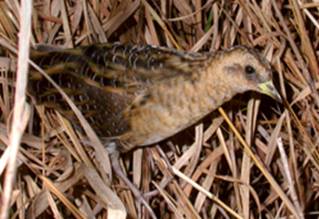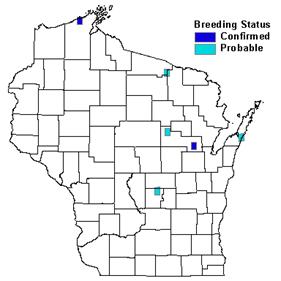Photo by Travis Mahan


Status/Protection
- Global Rank: G4 Key to global and state ranks
- State Rank: S1B
- WBCI Priority: WBIRD, SGCN, State Threatened
Population Information
The Federal BBS information can be obtained at http://www.mbr-pwrc.usgs.gov/bbs/bbs.html by clicking on Trend Estimates and selecting the species in question. All estimates are for time period (1966-2005).
- Federal Breeding Bird Survey: N/A
- Federal Breeding Bird Survey (WI): N/A
- Federal Breeding Bird Survey (BCR 23): N/A
- Federal Breeding Bird Survey (BCR 12): N/A
- North American Waterbird Conservation Plan: no population estimate
- WSO Checklist Project: N/A
Life History
- Breeding Range: Local across much of Canada and extreme northern U.S. (Bookhout 1995).
- Breeding Habitat: Northern Sedge Meadow and Marsh, Open Bog–Muskeg.
- Nest: Saucer-shaped with canopy of grasses or other vegetation over nest; on ground or mat of vegetation, sometimes over water (Ehrlich et al. 1988).
- Nesting Dates: Eggs: late May to late June (Robbins 1991).
- Foraging: Probes, ground glean (Ehrlich et al. 1988).
- Migrant Status: Short-distance migrant.
- Habitat use during Migration: Similar to breeding habitat as well as open, grassy areas (Peterjohn 1989, Granlund et al. 1994).
- Arrival Dates: Late April to late May (Robbins 1991).
- Departure Dates: Late August to early October (Robbins 1991).
- Winter Range: Coastal marshes from North Carolina to southern Texas; scattered records along California coast (Bookhout 1995).
- Winter Habitat: Drier portions of Spartina stands within coastal marshes, usually areas with damp soil but not with standing water (DeGraaf and Rappole 1995, Bookhout 1995).
Habitat Selection
Throughout its range, the Yellow Rail nests in wet sedge meadows, fens, boggy swales, and shallow marshes that contain a canopy of residual vegetation and damp soil or standing water (Bookhout 1995, Goldade et al. 2002). Water depth is an important predictor of Yellow Rail habitat, with most rails occurring in areas with <46 cm of water. Shallower depths are preferred around the nest site (<20 cm) but depths may vary throughout the nesting season due to natural water level fluctuations. In Wisconsin, the Yellow Rail often occurs in sedge marshes and meadows dominated by Carex lasiocarpa (Bookhout and Stenzel 1987, Hoffman 1990, Bookhout 1995, Ribic 1999) but also wetlands containing other Carex and grass species, especially bluejoint grass (Bookhout and Stenzel 1987, Mossman and Sample 1990). Although the Yellow Rail occurs in wetlands <1 ha and appears not to be area sensitive in some parts of its range (Goldade et al. 2002), Mossman and Sample (1990) suggested that this species requires large (>40 ha) tracts of habitat in Wisconsin.
Habitat Availability
Wisconsin’s sedge marshes and meadows historically suffered from drainage, ditching, filling, and grazing and more recently from commercial cranberry farming and mossing operations. These activities can result in permanent habitat loss or altered plant composition, thereby reducing habitat suitability for Yellow Rail and other sedge meadow-associated birds. Today, only 12,200 ha of sedge meadows and marshes remain in moderate to high quality (Mossman and Sample 1990). Although most of the remaining sedge meadows are highly fragmented, large tracts persist at Crex Meadows and Fish Lake Wildlife Areas (Burnett Co.) and Powell Marsh (Vilas Co.; Hoffman 2002). Yellow Rails consistently occur at these sites and less frequently at other wetland areas, including Bark Bay Slough State Natural Area (Bayfield Co.), Green Bay wetlands (Marinette Co.), Oconto Marsh (Oconto Co.), Mud Lake and Mink River Estuary State Natural Areas (Door Co.), Comstock Bog (Marquette Co.), and Killsnake Wildlife Area (Calumet Co.; Howe 2006). Seemingly suitable habitat exists in the Central Sand Plains ecological landscape but no recent records of Yellow Rail have been documented there.
Population Concerns
There is no information on population trends for Yellow Rail. Its secretive nature and localized breeding distribution makes it particularly challenging to monitor. Although numerous sources suggest that this species is more abundant than encounters would indicate, systematic surveys are needed to verify this (Bookhout 1995). In Wisconsin, it is considered a rare and very local summer resident with breeding confirmed only in Bayfield and Shawano counties (Howe 2006) and the Green Bay marshes (Robbins 1991). Loss and alteration of sedge meadow habitat on the breeding grounds are the greatest threats to Yellow Rail populations (Bookhout 1995).
Recommended Management
Conservation measures that protect sedge meadows and marshes from draining, channelization, and other forms of alteration will benefit the Yellow Rail as well as Le Conte’s Sparrow, Sedge Wren, and other sedge meadow-associated species. Although waterfowl management can be compatible with the maintenance of Yellow Rail habitat, rails generally require shallower water depths (<46 cm) and greater coverage of emergent vegetation than most waterfowl species. Thus, managers should maintain wetland complexes in a variety of conditions to support a diversity of wetland-associated species. Woody shrub encroachment reduces the suitability of wetland habitats and can be controlled by burning or mowing (Van Dam et al. 1993, Bookhout 1995). Conservation and management strategies for this species should focus in the following ecological landscapes: Northwest Sands, Central Sand Hills, Central Sand Plains, Forest Transition, Northern Highland, Superior Coastal Plain, and Northern Lake Michigan Coastal (WDNR 2005).
Research Needs
Systematic surveys of historical breeding sites and other suitable habitats would help refine our knowledge of this species’ status and distribution in Wisconsin. More information is needed on breeding habitat requirements in the state and management techniques that maintain these conditions. Additionally, the compatibility of waterfowl and rail management strategies needs more study. Little is known about Yellow Rail biology and associated limiting factors on the wintering grounds (Van Dam et al. 1993, Bookhout 1995).
Information Sources
- Cornell Lab of Ornithology species account: http://www.birds.cornell.edu/AllAboutBirds/BirdGuide/Yellow_Rail.html
- Michigan Natural Features Inventory species account: http://web4.msue.msu.edu/mnfi/abstracts/zoology/Coturnicops_noveboracensis.pdf
- National Audubon Society Watchlist species account: http://audubon2.org/webapp/watchlist/viewSpecies.jsp?id=228
- Nicolet National Forest bird survey map: http://www.uwgb.edu/birds/nnf/species/YERA.htm
- Northern Prairie Wildlife Research Center species account: http://www.npwrc.usgs.gov/resource/literatr/wetbird/yera/yera.htm
- The Nature Conservancy management abstract: http://www.conserveonline.org/2001/06/m/yera;internal&action=buildframes.action
- Wisconsin Breeding Bird Survey: http://www.uwgb.edu/birds/wbba/
- Wisconsin Department of Natural Resources fact sheet: http://www.dnr.state.wi.us/org/land/er/factsheets/birds/Ylrail.htm
References
- Bookhout, T.A. and J.R. Stenzel. 1987. Habitat and movements of breeding Yellow Rails. Wilson Bulletin 99: 441–447.
- Bookhout, T.A. 1995. Yellow Rail (Coturnicops noveboracensis). In The Birds of North America, No. 139 (A. Poole and F. Gill, eds.). The Academy of Natural Sciences, Philadelphia and the American Ornithologists’ Union, Washington, D.C.
- DeGraaf, R.M. and J.H. Rappole. 1995. Neotropical migratory birds: natural history, distribution, and population change. Comstock Publ. Assoc., Cornell Univ. Press, Ithaca, NY.
- Ehrlich, P.R., D.S. Dobkin, and D. Wheye. 1988. The birders handbook: a field guide to the natural history of North American birds. Simon & Schuster, Inc. New York.
- Goldade, C.M., J.A. Dechant, D.H. Johnson, A.L. Zimmerman, B.E. Jamison, J.O. Church, and B.R. Euliss. 2002. Effects of management practices on wetland birds: Yellow Rail. Northern Prairie Wildlife Research Center, Jamestown, ND. Northern Prairie Wildlife Research Center Online. http://www.npwrc.usgs.gov/resource/literatr/wetbird/yera/yera.htm (Version 12DEC2003).
- Granlund, T., G.A. McPeek, and R.J. Adams. 1994. The Birds of Michigan. Indiana University Press, Bloomington, IN.
- Hoffman, R.M. 1990. Birds of Wisconsin’s deep marshes and shallow open-water communities. Passenger Pigeon 52(3): 259-272.
- Hoffman, R.M. 2002. Wisconsin’s natural communities: how to recognize them, where to find them. University of Wisconsin Press, Madison, WI.
- Howe, R.W. 2006. Yellow Rail. In Atlas of the Breeding Birds of Wisconsin (N.J. Cutright, B.R Harriman, and R.W Howe, eds.). Wisconsin Society of Ornithology, Inc. 602pp.
- Mossman, M.J. and D.W. Sample. 1990. Birds of Wisconsin sedge meadows. Passenger Pigeon 52(1): 39-55.
- Peterjohn, B.G. 1989. The Birds of Ohio. Indiana University Press, Bloomington, IN.
- Ribic, C.A. 1999. Rails in Wisconsin, with a focus on Sora and Virginia Rail. Passenger Pigeon 61(3): 277-289.
- Robbins, S.D. 1991. Wisconsin birdlife: population & distribution, past & present. Univ. of Wisconsin Press, Madison, WI.
- Van Dam, B. 1993. Yellow Rail: species management abstract. The Nature Conservancy http://conserveonline.org/docs/2001/06/yera.doc (5 June 2007)
- Wisconsin Department of Natural Resources (WDNR). 2005. Wisconsin’s Strategy for Wildlife Species of Greatest Conservation Need. Madison, WI.
Contact Information
- Compiler: William P. Mueller, iltlawas@earthlink.net
- Editor: Kim Kreitinger, K.Kreitinger@gmail.com
